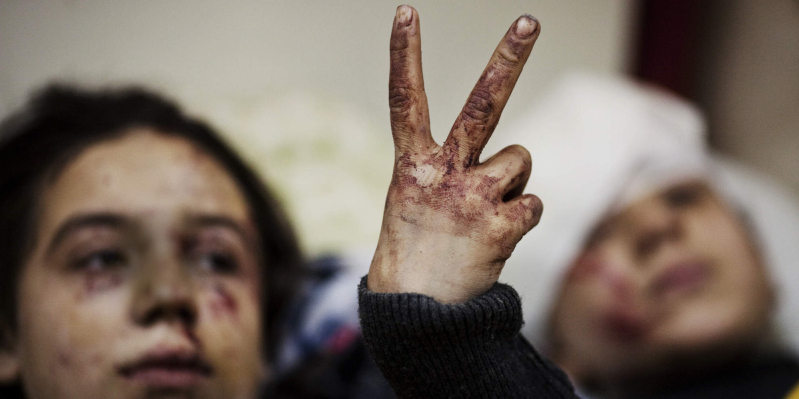
With Assad's forces coming into the fore in east Aleppo, besieging the area that rebels held as their ground for four years, UN reports state that both camps are getting more desperate with civilians being killed at gunpoint, and more children left alone with relatives slaughtered in the crossfire. The battle for Aleppo is drawing to a close, as some analysts say.
One Syrian activist sends this message to journalists, "Families got together awaiting death together. This is what's happening."
But what started the Syrian Civil War in the first place? An overview of key events from 2010-2015 is discussed below:
2010
Start of the "Arab Spring" or "Democracy Spring" that pertains to a series of revolutionary protests across the Arab region. The protest started in Tunisia which resulted in the Tunisian Revolution. Thereafter, similar protests occurred in surrounding countries: Iraq, Libya, Syria, Yemen, Bahrain, Egypt, Algeria, Iran, Lebanon, Jordan, Kuwait, Morocco, Oman, Sudan, Djibouti, Mauritania, the Palestinian territories, Saudi Arabia, Somalia, and the Western Sahara. Causes of the "Arab Spring" differ per country, but are constituted along the same themes: the fight for democracy, free elections, economic freedom, human rights, employment, regime change, creation of Islamic regime, and freedom from the influence of the United States.
2011
"Arab Spring" revolts resulted in the impeachment of Tunisian President Zine El Abidine Ben Ali and Egyptian President Hosni Mubarak.
Revolts trickled down to Syria and people called for President Bashar al-Assad's removal. Although Assad showed a promising leadership by opposing the United States' invasion and occupation of Iraq, and the Qatar-Turkey pipeline, he failed to act on Syria's high unemployment rate, class inequalities, inflation, and in distributing relief and support during the height of the country's most intense drought from 2007 to 2010.
The Free Syrian Army (FSA) was formed to fight against the Assad regime, made up of around 5,000 to 7,000 opposition fighters. FSA was headed by former Army Colonel Riad al-As'ad.
Charismatic leaders formed the National Coordination Committee for Democratic Change, an opposition group that puts forth the need to maintain a peaceful regime change, and the need to avoid a bloody revolution. The group was torn down eventually because of lack of public support, and with its leaders exiled.
In response to the attacks, Assad is supported by Iran and Russia for money and armament.
US, on the other hand, supported opposition groups.
2012
General Mustafa ash-Sheikh founded the Supreme Military Council (SMC) of the Free Syrian Army, another opposition group. This caused tension with FSA as both had the same aims but General ash-Sheikh failed to coordinate. Both Colonel al-As'ad and General ash-Sheikh then decided to join forces.
A revitalized SMC of the Free Syrian Army was formed, overseen by the Syrian National Coalition, the biggest anti-Assad group outside Syria. It is headed by stakeholders from Qatar and Saudi Arabia.
Turkey supported anti-Assad groups by sending its own troops, mainly those of Syrian descent.
2013
USA further supported opposition groups by providing weapons, money, training and supplies.
In response to opposition attacks, the Assad government upgraded its National Defense Forces (NDF), Syria's biggest paramilitary group. The group then stood between 60,000 to 100,000 pro-government fighters.
Al-Qaeda launched Nusra Front to fight against Assad's regime.
2014
Fighting continued but groups under the FSA wing became divided with different stakeholders for each coalition. SMC was defeated in northwest Syria. In the east, SMC was supported by the US in its fight against ISIS (Islamic State of Iraq and ash-Sham). In the south, SMC was supported also by the US.
Lebanon-based Hezbollah joined in on the pro-Assad side.
The Syrian Observatory for Human Rights placed the death toll at 300,000 people, with 80,052 of these civilians.
2015
Russia brought its troops to the ground. Increased fighting ensued.
The war has caused 55,219 more deaths, of which 20,977 of these are civilians.
On a UNHCR report, the war has also resulted in 6.5 million displaced and abandoned people, with relatives either killed or lost during the crossfires. An additional 4.5 million Syrian refugees have sought asylum in Turkey, Iraq, Jordan, Lebanon and Egypt. And an additional 813,000 sought for asylum in Europe.
But the numbers are said to be inconclusive, given that in 2008, there were 5.3 million people in Aleppo alone. By 2015, a humanitarian group says 4.8 million Syrians ended up as refugees, and 3 million children displaced without homes and families to go back to. The real death toll is said to be higher than the number reported.
The Syrian Civil War is a conglomeration of different state-directed frustrations not only in Syria, but also in the Arab region. However, it also reflects Syria's centrality in the economic, military, and geographical spheres with many countries from Asia, the Middle East, Russia, and the US joining the fight with their own interests at play. Sadly, millions of innocent civilians are caught in the crossfires, only to pay a price for a war they did not even know about.







